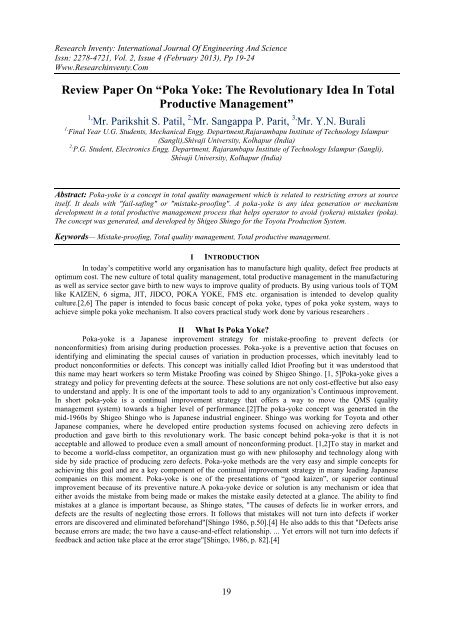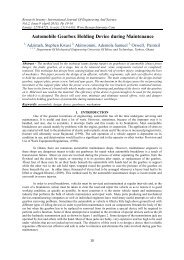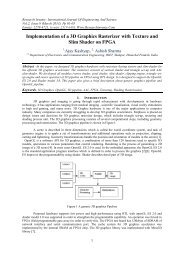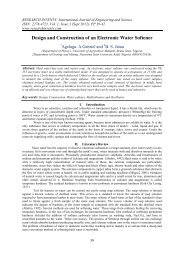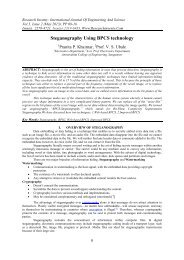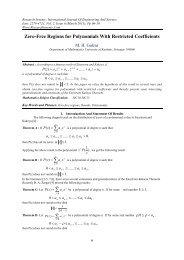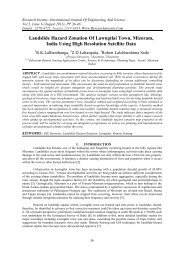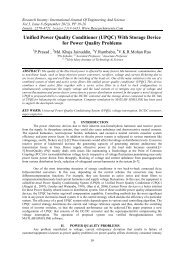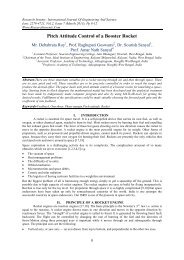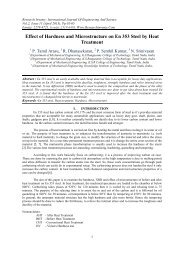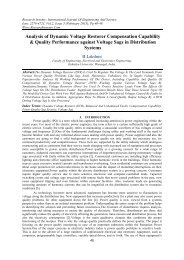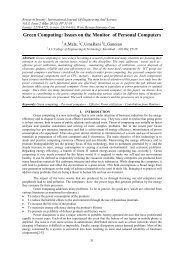Review Paper On âPoka Yoke: The ... - Research Inventy
Review Paper On âPoka Yoke: The ... - Research Inventy
Review Paper On âPoka Yoke: The ... - Research Inventy
Create successful ePaper yourself
Turn your PDF publications into a flip-book with our unique Google optimized e-Paper software.
<strong>Research</strong> <strong>Inventy</strong>: International Journal Of Engineering And Science<br />
Issn: 2278-4721, Vol. 2, Issue 4 (February 2013), Pp 19-24<br />
Www.<strong>Research</strong>inventy.Com<br />
<strong>Review</strong> <strong>Paper</strong> <strong>On</strong> “Poka <strong>Yoke</strong>: <strong>The</strong> Revolutionary Idea In Total<br />
Productive Management”<br />
1, Mr. Parikshit S. Patil, 2, Mr. Sangappa P. Parit, 3, Mr. Y.N. Burali<br />
1, Final Year U.G. Students, Mechanical Engg. Department,Rajarambapu Institute of Technology Islampur<br />
(Sangli),Shivaji University, Kolhapur (India)<br />
2, P.G. Student, Electronics Engg. Department, Rajarambapu Institute of Technology Islampur (Sangli),<br />
Shivaji University, Kolhapur (India)<br />
Abstract: Poka-yoke is a concept in total quality management which is related to restricting errors at source<br />
itself. It deals with "fail-safing" or "mistake-proofing". A poka-yoke is any idea generation or mechanism<br />
development in a total productive management process that helps operator to avoid (yokeru) mistakes (poka).<br />
<strong>The</strong> concept was generated, and developed by Shigeo Shingo for the Toyota Production System.<br />
Keywords— Mistake-proofing, Total quality management, Total productive management.<br />
I INTRODUCTION<br />
In today’s competitive world any organisation has to manufacture high quality, defect free products at<br />
optimum cost. <strong>The</strong> new culture of total quality management, total productive management in the manufacturing<br />
as well as service sector gave birth to new ways to improve quality of products. By using various tools of TQM<br />
like KAIZEN, 6 sigma, JIT, JIDCO, POKA YOKE, FMS etc. organisation is intended to develop quality<br />
culture.[2,6] <strong>The</strong> paper is intended to focus basic concept of poka yoke, types of poka yoke system, ways to<br />
achieve simple poka yoke mechanism. It also covers practical study work done by various researchers .<br />
II What Is Poka <strong>Yoke</strong><br />
Poka-yoke is a Japanese improvement strategy for mistake-proofing to prevent defects (or<br />
nonconformities) from arising during production processes. Poka-yoke is a preventive action that focuses on<br />
identifying and eliminating the special causes of variation in production processes, which inevitably lead to<br />
product nonconformities or defects. This concept was initially called Idiot Proofing but it was understood that<br />
this name may heart workers so term Mistake Proofing was coined by Shigeo Shingo. [1, 5]Poka-yoke gives a<br />
strategy and policy for preventing defects at the source. <strong>The</strong>se solutions are not only cost-effective but also easy<br />
to understand and apply. It is one of the important tools to add to any organization’s Continuous improvement.<br />
In short poka-yoke is a continual improvement strategy that offers a way to move the QMS (quality<br />
management system) towards a higher level of performance.[2]<strong>The</strong> poka-yoke concept was generated in the<br />
mid-1960s by Shigeo Shingo who is Japanese industrial engineer. Shingo was working for Toyota and other<br />
Japanese companies, where he developed entire production systems focused on achieving zero defects in<br />
production and gave birth to this revolutionary work. <strong>The</strong> basic concept behind poka-yoke is that it is not<br />
acceptable and allowed to produce even a small amount of nonconforming product. [1,2]To stay in market and<br />
to become a world-class competitor, an organization must go with new philosophy and technology along with<br />
side by side practice of producing zero defects. Poka-yoke methods are the very easy and simple concepts for<br />
achieving this goal and are a key component of the continual improvement strategy in many leading Japanese<br />
companies on this moment. Poka-yoke is one of the presentations of “good kaizen”, or superior continual<br />
improvement because of its preventive nature.A poka-yoke device or solution is any mechanism or idea that<br />
either avoids the mistake from being made or makes the mistake easily detected at a glance. <strong>The</strong> ability to find<br />
mistakes at a glance is important because, as Shingo states, "<strong>The</strong> causes of defects lie in worker errors, and<br />
defects are the results of neglecting those errors. It follows that mistakes will not turn into defects if worker<br />
errors are discovered and eliminated beforehand"[Shingo 1986, p.50].[4] He also adds to this that "Defects arise<br />
because errors are made; the two have a cause-and-effect relationship. ... Yet errors will not turn into defects if<br />
feedback and action take place at the error stage"[Shingo, 1986, p. 82].[4]<br />
19
<strong>Review</strong> <strong>Paper</strong> <strong>On</strong> “Poka <strong>Yoke</strong>: <strong>The</strong> Revolutionary Idea...<br />
Fig. 1 General activity aim at prevent defects [1]<br />
During actual manufacturing of any product there are too many very simple and monotonous steps<br />
which are carried out by operators. <strong>The</strong>se monotonous work operations result in to mental fatigue and lack of<br />
interest in work which ultimately causes silly mistakes of operators and we know that human is prone to errors<br />
even though he doesn’t want it. [5]To avoid these simple mistakes poka yoke concept play important role. By<br />
implementing some simple solutions we can avoid mistakes. <strong>The</strong> long term success of poka yoke gives output<br />
of saving time and we release the work pressure on mind of worker. We can use creativity and special skills of<br />
workers for more creative operations instead of increasing pressure for monotonous activities This involvement<br />
of everyone in organisation is basic need to rise roots of quality culture in the organisation.<br />
III Need Of Mistake Proofing<br />
When any organization decides to implement the lean manufacturing then one of the objective is to<br />
reduce scrap because no one is interested to compensate extra inventory on account of scrap. As per philosophy<br />
of lean manufacturing it focuses on speed of production and productivity also. In order to follow this concept of<br />
speed we should prevail against defects and rework. To increase profit percentage the cost pressures always<br />
become headache for top management so they never accept continued mistakes like scrap, rework, lateness etc<br />
out of tolerance instead they are aiming to achieve value of zero in this segment. When customers of any<br />
company buys product they rightfully expect defect free products and conventional 100% inspection or<br />
statistical process control don’t insure 100% defect-free products. [1]Hence we are going to root cause of any<br />
problem and avoiding it which gives us defect free product. <strong>The</strong> above discussion concludes that to get defect<br />
free products one should go with the concept of Poka <strong>Yoke</strong>.<br />
IV Types Of Poka <strong>Yoke</strong><br />
<strong>The</strong> Poka-<strong>Yoke</strong> is a technique for to keep away human error at work. A defect or imperfection exists in<br />
either of two states; the defect either has already occurred in that case calling for defect detection, or is about to<br />
occur in that case calling for defect prediction. <strong>The</strong> technique starts by analyzing the process for potential<br />
problems, identifying parts by the characteristics of dimension, shape, and weight, detecting process deviation<br />
from nominal procedures and norms.<br />
Depending on the basic functionality Poka-yoke has three types:[2]<br />
1] Shutdown Poka yoke<br />
2] Control Poka yoke<br />
3] Warning Poka yoke<br />
Fig. 2 Types of poka yoke [1]<br />
20
<strong>Review</strong> <strong>Paper</strong> <strong>On</strong> “Poka <strong>Yoke</strong>: <strong>The</strong> Revolutionary Idea...<br />
4.1 Shutdown (Prevention) Method<br />
In shut down i.e. prevention method Poka-yoke devices checks critical process parameters and shut<br />
down the process when a situation moves out of the tolerance zone, it is indication of a defective product has<br />
either been produced or is about to be produced. [2]It is well known note that prevention is always better than<br />
cure. By implementing shutdown method we can assure about 100% defect free products.[1] It has 0 % chances<br />
to produce defective product, up to this level we can reliance on it.[2] E.g. Use of fuse in electric circuit. When<br />
there is short circuit then fuse is operated and cut down the supply of electricity resulting in avoiding any further<br />
accidents.<br />
4.2 Control method<br />
In control method Poka-yoke devices are regulatory in working which are installed on process<br />
equipment and/or Work pieces which make it impossible to produce defects and/or to flow a nonconforming<br />
product to the next process.[2] As like shut down method control method gives 100% defect free products.<br />
[1]<strong>The</strong> control make certainty that if there is any defect, it’s not coming outside the production line and does not<br />
reach to the customer. E.g. To avoid wrong job loading in reverse direction on machine we can provide work<br />
rest for the job which will avoid wrong job loading.<br />
4.3 Warning (Alert) method<br />
This is the method which makes the operator conscious about something is going wrong. <strong>The</strong><br />
mechanism or simple idea is generated in such a way that Poka-yoke devices indicate or shows to a worker that<br />
a defect has been produced. When operator gets such warning then he must immediately interfere the process to<br />
correct the process (es) responsible for causing the defect. In case of irresponsible behavior of operator<br />
irrespective of getting warning notice the next products will continue the same defect and produce<br />
nonconforming products. [2] In short again this method depends on human nature and behavior. It is concluded<br />
that alert method gives 30% of the guarantee of good products. Actually this method tells about existence of<br />
defect but does not assure and does not produce 100% quality. [1]<strong>The</strong> common warning methods are use of<br />
blinking light and use of beeping sound as alarm. e.g. Beeping sound or flashing of light in ATM machine after<br />
removing ATM card from machine to warn operator that he is safe and ensure that card is not in machine.<br />
V Methodology of poka yoke [1]<br />
Identify Problem<br />
Observation at workstation<br />
Brainstorming for idea<br />
Select best idea<br />
Implementation Plan<br />
Implement<br />
Monitor and sign off<br />
Fig. 3 Steps to implement poka<br />
yoke<br />
<strong>On</strong>ce top management decides to implement TPM culture in organization then to compensate for defect free<br />
products successfully one should follow the following methodology<br />
5.1 Step 1 Identify problem<br />
In this stage the complaints coming from the customers (Both internal and external customer) are<br />
collected. <strong>The</strong> principle of standard is determined by considering various criteria’s like number of complaints<br />
from the customer, the quantity of defects detected by quality control, materiality defects (their impact on the<br />
customer, costs, implemented process) and then data is collected broadly. As per analysis results of the collected<br />
data company plans for developing poka yoke system for the selected problem. In this way in first stage the<br />
problem is selected,<br />
21
<strong>Review</strong> <strong>Paper</strong> <strong>On</strong> “Poka <strong>Yoke</strong>: <strong>The</strong> Revolutionary Idea...<br />
5.2 Step 2 Observation at work stations<br />
In this step the actual on site study of the problem is carried out. <strong>The</strong> causes behind the problem are<br />
sort out by using fishbone diagram (fishbone diagram is cause and effect diagram given by Japans management<br />
guru Ishikawa).<strong>The</strong> causes may be related to man, machine, material or method accordingly the complete<br />
sorting is carried out.<br />
5.3 Step 3 Brainstorming for Idea<br />
This is a technique to capture creativity and skills of employee’s .In brainstorming session the problem<br />
under study is put forward to committee. <strong>The</strong>n all members study problem and give various solutions to avoid<br />
that defect. As each person has one uniqueness this step concludes with various alternative solutions for same<br />
problem.<br />
5.4 Step 4 Select best ideas<br />
After getting various alternative solutions it is time to select best one out of all collected solutions.<br />
Criteria for selection may be cost, time required, changes in existing system, opportunity to develop new<br />
solutions, simplicity in operation etc. By referring all selection criteria’s committee concludes With one best<br />
solution.<br />
5.5 Step 5 Implementation plan and implementation<br />
This step is concerned with implementation planning. It deals with material requirement, processing the<br />
material and finally manufactured mechanism is implemented at actual working site.<br />
5.6 Step 6 Monitoring and sign off<br />
<strong>The</strong> manufactured products are checked for defects under study also the performance of poka yoke<br />
system is also monitored and project is shut downed.<br />
Fig. 4 PDCA cycle to implement poka yoke [1]<br />
Example:-<br />
Problem: - Job loading in reverse direction causing job rejection, damage to tool and machine geometry<br />
Aim: - To ensure correct loading of job<br />
Ideas After Brain Storming:-When problem is taken on the table of brainstorming the following options are<br />
obtained for above mentioned problem<br />
Use of proximity sensor to detect reverse loading of job.<br />
Use of photo sensor.<br />
Instructions to operator.<br />
Separate fixtures to keep the incoming job to enable operator to load the job correctly.<br />
Painting the correct and wrong end of job with different colors.<br />
Use of color sensors to differentiate between correct and wrong end of job.<br />
To provide work rest for the job.<br />
To provide mechanical stopper. Etc.<br />
From the analysis of various solutions the meeting concludes that they should go with last option i.e. to provide<br />
mechanical stopper.<br />
22
<strong>Review</strong> <strong>Paper</strong> <strong>On</strong> “Poka <strong>Yoke</strong>: <strong>The</strong> Revolutionary Idea...<br />
Fig. 5 Poka yoke the simple practical implementation [3]<br />
Now they will plan for implementing the selected solution and monitor for the result and switch over to next<br />
problem.<br />
VI Principles Of Poka <strong>Yoke</strong><br />
Imperfections faults arise most as a result of human errors and mistakes. Even though the worker is conscious of<br />
the mistake he makes, he repeats to do the same.<br />
Here is list of some most common errors incurred by operators as below- [1, 5]<br />
1) <strong>The</strong> errors due to the misunderstanding<br />
2) Incorrect identification<br />
3) Good intentions but improperly implemented<br />
4) Processing omissions (a step was forgotten)<br />
5) Processing errors (something was done incorrectly)<br />
6) Error in setting up the work piece<br />
7) Assembly omissions (a part was forgotten)<br />
8) A wrong part / item was included<br />
9) Wrong work piece<br />
10) Operations errors (incomplete information, Lack of training ,procedures not followed)<br />
11) Adjustment, measurement, dimensional errors<br />
12) Equipment maintenance errors<br />
13) Errors in preparation of tools, fixtures, blades etc. Etc.<br />
All errors arising in the company are kept on record and then analysed. Most of them can be prevented by using<br />
techniques Poka-<strong>Yoke</strong>.<br />
VII Methods Of Obtaining Poka <strong>Yoke</strong><br />
Poka yoke ideas are simple but creative in operation and generation. According to Shingo [Shingo,<br />
1986, p.71], "Defects will never be reduced if the workers involved do not modify operating methods when<br />
defects occur." [4]<br />
Following are some of the simple ideas (hints) to avoid mistakes: - [5]<br />
1) Using Shapes and Colors<br />
2) Software Warnings and Reminders<br />
3) Using Dialogue Boxes and Software Checks<br />
4) Using Switches and Automatic Braking<br />
5) Using Checklists<br />
6) Visual Prevention Methods<br />
7) Using Lights, Sounds, Signs and Barriers Etc.<br />
VIII Challenges And Limitations Of Poka <strong>Yoke</strong><br />
As per up till discussion in the paper it seems that poka yoke is one of the best tool in total quality<br />
management but we have to think about the obstacles and challenges against poka yoke.<br />
.<br />
23
Some of challenges are listed below-<br />
<strong>Review</strong> <strong>Paper</strong> <strong>On</strong> “Poka <strong>Yoke</strong>: <strong>The</strong> Revolutionary Idea...<br />
1. Practical implementation of the mechanism or solution is not possible.<br />
2. Process parameters don’t allow changing the existing system.<br />
3. Sometimes the poka yoke is not cost effective.<br />
4. Interdepartmental relations between production and quality dept are not good so each one think that I don’t<br />
have to do anything with that issue.<br />
5. Now also we are depending on statistical process control.<br />
6. Expert advice is needed for new creative and challenging tasks .It may happen that experts are not available<br />
with small scale industries and expert advice is not economical for their financial health.<br />
IX Examples Of Poka <strong>Yoke</strong><br />
1. Spindle of CNC machine starts only after closing the safety door. If door is open then machine will not run.<br />
It is shut down poka yoke to avoid accidents.<br />
2. <strong>The</strong> guide pins are used in stamping dies for correct alignment of upper and lower portion. If there is<br />
improper matching assembly of dies will not take place. It is shut down poka yoke.<br />
3. If we want to close any file in operating software (e.g. Microsoft Word) it asks for save it or cancel dialogue<br />
box. This is warning system against by mistake closing of file. It is warning poka yoke.[5]<br />
4. To avoid parallax error in reading the measuring instrument small mirror is placed below the moving<br />
pointer. By referring pointer and its mirror image we can take proper reading. It is warning poka yoke.<br />
5. <strong>The</strong> socket for USB on the computer is designed in such a way that we can’t connect pen drive or any<br />
corresponding pin in opposite or wrong way. It is control poka yoke system.[5]<br />
6. Pressure relief valves are used in hydraulic circuit to prevent damage to system due to high pressure. In case<br />
of high pressure the excess oil bleed off through check valve to the reservoir. It is control poka yoke<br />
system.<br />
7. Check list is used to confirm that all subcomponents in assembly are assembled. It is control poka yoke<br />
system.[2]<br />
X Conclusion<br />
To err is human nature so we can’t blame human being for each and every mistake. As like err,<br />
Intelligence is also human nature so we can dominate preceding nature by next nature. Poka yoke is just a face<br />
of that intelligence. We can avoid the mistakes at the source itself by using above mentioned methodology.<br />
About mistake proofing we can say that it is a system for organizing work that eliminates any chances of error<br />
by new user also. It also allow user to function without mistake or prevent error that are about to occur. In order<br />
to implement quality management system successfully each activity should aim towards excellence. Poka yoke<br />
is one of the most important tool in TQM. Successful poka yoke results in increased productivity with minimum<br />
waste (waste due to rework, scrap) because we are sure about the quality of product, as mistakes are blocked at<br />
source itself. <strong>The</strong>re may be some practical limitations in poka yoke but we have to overcome all that for<br />
achieving the aim of “Zero Defects, Zero Waste and Zero Delays”. In one sentence poka yoke is launching<br />
preventive actions for systematic movement on the success ladder of QMS with higher level of performance and<br />
productivity of system with high quality products at minimum cost.<br />
References<br />
[1] M. Dudek-Burlikowska*, D. Szewieczek , “<strong>The</strong> Poka-<strong>Yoke</strong> method as an improving quality tool of operations in the process”; Journal<br />
of Achievements in Materials and Manufacturing Engineering VOLUME 36<br />
ISSUE 1 September 2009<br />
[2] Stewart Anderson,“Poka-<strong>Yoke</strong>: Mistake-Proofing as a Preventive Action”; THE INFORMED Outlook Reprint: March 2002Volume<br />
7, Number 3<br />
[3] PAUL DVORAK Senior Editor; “Poka-yoke designs make assemblies mistake proof”; http://www.penton.com/md MARCH 10, 1998<br />
MACHINE DESIGN<br />
[4] John R. Grout, and Brian T. Downs; “A Brief Tutorial on Mistake-proofing, Poka-<strong>Yoke</strong>, and ZQC”; Lean Business Solutions United<br />
States<br />
[5] “Lean Six Sigma Operational - Delegate Workbook”; Mistake Proofing techniques; <strong>The</strong> British Standards Institution;<br />
SSG06101ENUK - MP/Issue 1.1/ September 2008<br />
[6] Anil S. Badiger, R. Gandhinathan, V. N. Gaitonde, Rajesh S. Jangaler<br />
“Implementation of Kaizen and Poka-yoke to Enhance Overall Equipment Performance - A case study”<br />
24


